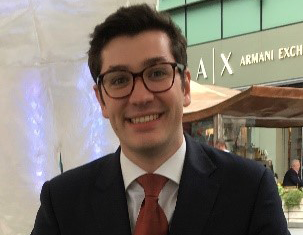“Nothing about us without us”: how patient advocacy is changing the game

When it comes to advancing medical care, there is no denying that patients are at the core of everything we do. However, direct patient involvement in this process has only recently started to become a reality. To give us some insight into this, YoungEHA reached out to Zack Pemberton-Whiteley (@ZPWLC), Patient Advocacy Director at Leukaemia Care (UK) and Chair of the global Acute Leukemia Advocates Network (ALAN).
NB: Zack, thanks so much for speaking with us. Can you start by telling us how you became involved with patient advocacy?
ZPW: Quite unusually for a patient advocate, I have no personal or family connection to leukaemia. After finishing my law degree, I was looking for opportunities to make use of the advocacy skills I’d developed. I’ve always been passionate about science and healthcare, so patient advocacy was a chance to combine the two. My work at Leukaemia Care mostly focuses around the policy side of patient advocacy. I view my job as speaking up on behalf of patients, aiming to represent the patient voice when decisions that affect patients are being made. I find that not having a personal connection can be quite helpful, as it allows me to speak on behalf of the collective viewpoint of patients, rather than speaking about my own individual experiences.
NB: What does a normal day involve for you?
ZPW: In the world of patient advocacy, I’m not sure there is such thing as a normal day! In a single week you can go from presenting at a scientific conference; to talking with individual patients to try to resolve an issue they’re experiencing; to responding to a policy consultation about a new service or drug; to trying to design new patient support services for Leukaemia Care (such as WhatsApp support, counselling or travel grant programs). The three words I would use to describe my role are varied, busy and rewarding. The slogan “Nothing about us without us” can lead patient advocates to get involved in a variety of projects. We vote with our feet and spend our time on the projects where we feel we can have most impact for patients.
Every stakeholder has a different perspective on what they believe patients think (…) If you want to know what patients think – ask them!
NB: Which aspect of your job is your favorite?
ZPW: Anyone who knows me would tell you that my favorite topic to talk about is Health Technology Assessment (HTA) and access to treatment in general. Scientific advances are meaningless unless they reach patients. I frequently present on the topic of patient involvement in HTA. One of the biggest issues with patient involvement in HTA is demonstrating the impact of that involvement, as current processes usually lack a mechanism to ensure the patient voice actually influences the final decision, rather than just adds context. Many of the issues could equally be applied to inadequate involvement of healthcare professionals in HTA. It’s not about ‘getting more drugs approved’, but about making sure the drugs that add most benefit are available to the patients that need them.
NB: Patient advocacy has had an increasingly prominent role at academic conferences. What impact do you think this is having on patient care?
ZPW: I think this is hugely important. As an example, this year at EHA I gave three presentations relating to quality of life and patient involvement, having not previously spoken there. Patient advocates provide a completely different perspective and I would love in the future to see a patient advocate involved in nearly every session, to give the patient perspective on the topic but also to present our own work. Patient advocacy organisations are increasingly sharing research projects at conferences, but this is usually confined to poster sessions. Patient advocacy attendance (never mind involvement) in conferences is still an issue. I’ve lost count of the number of conferences where I’ve been a speaker, but not allowed to attend the rest of the sessions. EHA have been a leader in this regard, providing over 50 places for patient advocates at the conference over the last few years. Hopefully others - including ASH - will follow suit! Patient advocates also have a huge role to play in raising awareness of the latest advances, sharing that information with patients. This is particularly evident on social media where the key ‘influencers’ of #EHA24 on Twitter included EHA, myself, VJHemOnc and the CML Advocates Network in the top four, and also Myeloma Patients Europe in the top ten.
Patient advocacy attendance in conferences is still an issue (…) EHA have been a leader in this regard, providing over 50 places for patient advocates at the conference over the last few years.
NB: Your work is based in the United Kingdom. Do you think there is a role for co-operation between patient advocacy organisations across countries?
ZPW: Definitely. Despite my day job being based in the UK, we spend an increasing amount of my time collaborating on international activities. There are umbrella groups each with a different remit, such as the Acute Leukemia Advocates Network (ALAN), CML Advocates Network or across cancer the Workgroup of European Cancer Advocacy Networks (WECAN). Some projects or campaigns can only be undertaken (or most effectively undertaken) at an international level, such as ALAN’s global quality of life survey on acute leukaemia. And in terms of patient voice, coalitions of organisations working together can have a much greater impact than a single organisation speaking out alone.
NB: Do you think there is a role for researchers in patient advocacy?
ZPW: Anyone can advocate for patients, as anyone can speak up for patient interests when decisions are made. Article 8 of the Helsinki declaration tells us that while the primary purpose of medical research is to generate new knowledge, this can never take precedence over the rights and interests of the individual. The patient’s interests are paramount. But in practice this is not always the case, because the interests of patients are not often appropriately considered. Every stakeholder has a different perspective on what they believe patients think, with most stakeholders being more risk averse than patients who are actually facing that situation. If you want to advocate for patients in your work, the best way to do this is to include existing patient advocacy organisations and conduct (or utilize existing) evidence-based research (e.g. surveys) on the patient perspective to design projects and research that work for patients. If you want to know what patients think – ask them!
Anyone can advocate for patients (…) While the primary purpose of medical research is to generate new knowledge, this can never take precedence over the rights and interests of the individual.
NB: How do you feel clinicians can do more to ensure patient views are taken into consideration when it comes to designing new treatments?
ZPW: I think the whole drug development process needs a rethink. The system requires a mindset shift from investigating areas where a drug may have clinical benefit, to starting with understanding the unmet needs in an area and designing drugs to address the identified needs of patients. At present, particularly in the early phases of research there is little patient involvement and limited understanding of their unmet needs and experience. This leads to patients being exposed to unnecessary procedures and ineffective treatment in the name of research. In many cases, research is undertaken without PROMs (patient-reported outcome measures) to collect Quality of Life data, or with ineffective historic tools. If you want to measure patient experience, you need a tool that was developed with the patient community, to reflect the issues that actually matter to patients. In haematology, for me that means using the HM-PRO which was developed by EHA’s scientific working group on QoL and symptoms, with involvement of patient advocates.
NB: From your experience, how does haematology compare to other fields when it comes to patient representation?
ZPW: The HIV community has been very active for many decades. But after that, the cancer patient advocacy community is one of the most engaged and capable around, particularly in the field of haematology. There’s a list of the international umbrella organisations EHA works with on the website and through these groups you can find the organisation that is active in your country. These groups are getting increasingly involved, with initiatives such as the IMI HARMONY project. I would really encourage anyone attending future EHA conferences to attend the patient advocacy track on a Saturday to meet these advocates. But in the meantime, visit their websites to understand the kind of work that is going on in the patient advocacy community.
NB: Finally, what do you think the future holds for patient advocacy?
ZPW: ‘Patient centricity’ has been a buzzword for regulators, payers and the pharmaceutical industry for a while now. It is definitely on the increase, but in practice very few people are doing it well. Involving the patient community means involving advocates who can share their collective experience, not just involving individual patients. I think that effective patient involvement requires improvement from all stakeholders: the patient advocacy community, payers and regulators, industry, and clinicians. Overall, stakeholders need to consider patient input as equally valid, but different to, that of clinicians. My simple mantra is: any time you consider including a clinician in the development of a project, ask if you should also include a patient advocate. I think things are changing, but there is certainly a long way still to go.
NB: Thanks again, Zack, and we look forward to seeing you next June in Frankfurt for EHA 2020!



 Back
Back